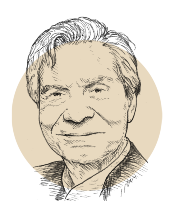In December 1940, the United States was still a neutral bystander in the conflict between Nazi Germany and its European neighbors. Only Great Britain was continuing to resist. Roosevelt knew that Americans were hostile to direct intervention, which would lead to sacrifices comparable to those made in World War I. However, he also believed that it was America’s duty to fight Nazism. The solution to his dilemma was therefore to provide Britain with enough weapons to survive. This is the model currently being applied to Ukraine. Thanks to this rearguard arsenal – in both material and moral terms – the British were able to hold out until the United States entered the war in the wake of Pearl Harbor.
Since 1945, relative global peace and a balance of power have been propped up by the notion of an all-American arsenal of democracy. The United States has a stockpile of weapons that would enable it to wage two wars simultaneously at any one time. This firepower and its domestic technology form the backbone of NATO, and this commitment by the United States “allows” the alliance’s other members to limit their arms industry and maintain a fairly modest professional military. However, these roles are beginning to change.
This shift was initiated in 2011 by Barack Obama, the first American president to have no particular affection for Europe. He believed that the United States should pivot towards Asia, as China was now perceived as the main threat to the country’s status as the leading global power. The effects of this strategic reversal, which has been pursued by both Donald Trump and Joe Biden (the continuity of U.S. foreign and military policy cannot be stressed enough), are starting to be felt in Europe – an awareness accelerated by Russia’s invasion of Ukraine in February 2022. As a result, the U.S. is turning against China, worrying about the fate of Taiwan, and growing closer to Australia, India, and Japan. But is such hostility towards China even realistic? Is this a classic case of artificial posturing? In China, communist leaders have invented a sham nationalism to keep themselves in power. In the United States, there may really be, as President Dwight Eisenhower put it, a “military-industrial complex” that requires a constant enemy. The invention of China as a real or virtual adversary gives American defense a raison d’être. As for the Europeans, they were not even consulted.
In the future, Europe will therefore find itself increasingly alone, facing a Russian threat that Americans, and Trump’s supporters in particular, see as a regional affair. Viewed from the United States, Russia only threatens Central Europe, not the western part of the continent or America’s interests. With this in mind, should the arsenal of democracy move from the United States to Europe? I would say yes, in part, as European armies and industries are playing an increasingly decisive role both in helping Ukraine and in preventing Russia from attacking former Soviet assets such as the Baltic states, Moldova, and Eastern Poland. So far, Europe is holding firm, with the exception of Hungary, which nobody pays much attention to anyway. Yet in its attempt to viably take over from the United States and save Ukraine, Europe is discovering that it does not have sufficient might. Taking into account what was called the “peace dividend” after the fall of the U.S.S.R., the domestic arms industry has been relatively idle since the 1990s. Europe will need around five years to reach American production capacity and become the new arsenal of democracy. But will Ukraine survive until then?
It therefore now falls to Europe to develop its arsenal while becoming the new beacon of democracy. After all, America’s strength lies not only in its military superiority, but also in the more or less credible claim that it embodies the universal concept of democracy. As it withdraws from both the European military sphere and the intellectual arena, could the United States still symbolize the universal notion of democracy if Trump is re-elected? Unlikely! As a result, Europe is faced with a twofold mission: to rebuild its industry, and to be sufficiently democratic in spirit and function to symbolize freedom and oppose the illiberal backsliding currently seen the world over. Yet democracy in both Europe and the United States does not enjoy unanimous support. Totalitarian ideas are on the rise in France, Germany, Italy, Hungary, Slovakia, Moldova, and Spain – hardly an inspiration for democratic dissidents in China or the Arab world.
The European Union is no model, either. We know that the most important decisions are made in the corridors of the Commission in Brussels, not in its Parliament. If Europe truly aspires to become the arsenal of democracy, the people of Europe should be invited to take part in a public debate to define what is expected of them – economic sacrifice to rebuild the arms industry, and political selflessness to set an example to the world. For the moment, these questions have not been asked and any debate remains hushed. As things stand, we are blind to the future.












